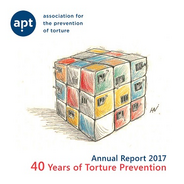Since Jean-Jacques Gautier’s original idea of a system of visits to places of detention, prevention has progressed. The transparency of places of deprivation of liberty has increased and the need for safeguards to prevent violations is now recognised. The timeline and this annual report show APT’s driving role in these developments.
For the first time the APT is making available an online version. You can also check on how APT is doing in implementing its Agenda for Change and four-year Strategic Plan, and discover the coherence of its work in 2107 with everything that has come before it.
For example the conclusions of the independent research APT commissioned a few years ago, has influenced its work in paying more attention to ensuring that detention safeguards are in place and their functioning supervised by public oversight bodies. This is therefore a good example of how APT mobilises states, experts and civil society around a reform agenda that can lead to real improvements.
Bringing about change in detention policy and practice is rarely easy and almost all of APT’s partners need their help to revise laws, train them on detention monitoring and accompany them through specific national reforms that can take several years. For examples, see the APT’s work with emerging National Preventive Mechanisms in the North Africa region.
However, much can be done now to better protect the dignity and rights of all persons deprived of their liberty, especially those who are most vulnerable to abuse and discrimination. For example custody hearings in Brazil have led to a reduction in arrested persons being sent to pre-trial detention and APT’s advice to judges on this procedure contributes to deterring police abuses.
Source: Association for the Prevention of Torture (APT)

